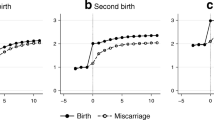Abstract
In recent years, a number of celebrities have begun childbearing after age 35. The phenomena of older first-time mothers has received a great deal of attention in the popular press. Are these celebrities indicative of a national trend? Does the increase in fertility portend a reversal of the declines in fertility which have been occurring since the baby boom? The present paper uses central and cumulative birth rates for cohorts of American white women born between 1882 and 1953 to investigate childbearing between ages 35 and 50. While there has been a noticeable upsurge in first birth rates for cohorts in their mid to late 30s in recent years, overall central birth rates for women in their 30s are among the lowest on record, with cumulative birth rates at record low levels. A major reason for this is that these women are having relatively few third and higher order births. These cohorts will need to have a relatively high proportion of births in their older years of childbearing in order to reach replacement level. However, attaining replacement level is unlikely because such a high proportion of women have remained childless at ages 35–40 and a relatively low proportion are having three or more children.
Similar content being viewed by others
References
Bloom, D.E. (1982). ‘What's happening to the age at first birth in the United States? A study of recent cohorts’, Demography 19: 351–70.
Boodman, S. (1990). ‘The last of the first-time mamas’, The Good Health Magazine in The Washington Post, April 29: 12,14, 15, 28.
Campbell, A. (1978). ‘Baby boom to birth dearth and beyond’, Annals of the American Academy of Political and Social Science 435 (January): 40–59.
Chen, R. and S.P. Morgan (1991). ‘Recent trends in first birth timing in the United States: An update and reexamination of earlier projections’. Paper presented at the Population Association of America Meetings in Washington, D.C.
Espenshade, T.J. and W.J. Serow (eds.) (1978). The Economic Consequences of Slowing Population Growth. New York: Academic Press.
Evans, M.D.R. (1986). ‘American fertility patterns: A comparison of white and nonwhite cohorts born 1903–56’, Population and Development Review 12: 267–93.
Hendershot, G.E. and P.J. Placek (eds.) (1981). Predicting Fertility. Lexington, Massachusetts: D.C. Heath and Company.
Heuser, R.L. (1976). Fertility Tables for Birth Cohorts by Color: United States, 1917–73. Rockville, Md.: National Center for Health Statistics, DHEW Publication No. (HRA) 76–1152.
Hilton, P. (1988). ‘Delayed Motherhood raises risks and rewards’, USA Today, July 7: 5D.
Kasindorf, J. (1989). ‘Mommy oldest: Having babies at 45 and beyond’, New York, July 17: 22–29.
Kiser, C., W. Grabill, and A. Campbell (1968). Trends and Variations in Fertility in the United States. Cambridge, Massachusetts: Harvard University Press.
National Center for Health Statistics (1978–1990, annual). Vital Statistics of the United States: Volume I, Natality (data years 1974–1988). Washington, D.C.: United States Government Printing Office.
O'Connell, M. and C.C. Rogers (1983). ‘Assessing cohort birth expectations data from the current population survey, 1971–1981’, Demography 20: 369–384.
Rindfuss, R. and L. Bumpass (1976). ‘How old is too old? Age and the sociology of fertility’, Family Planning Perspectives 8: 226–230.
Rindfuss, R. and J. Sweet (1977). Postwar Fertility Trends and Differentials in the United States. New York: Academic Press.
Rindfuss, R., P. Morgan, and G. Swicegood (1988). First Births in America: Changes in the Timing of Parenthood. Berkeley, Ca.: University of California Press.
Teitelbaum, M.S. and J.M. Winter (1985). The Fear of Population Decline. New York: Academic Press.
United States Bureau of the Census (1988). Fertility of American women: June 1987. Current Population Reports. Series P-20, No. 427. Washington: U.S. Government Printing Office.
Ventura, S.J. (1989). Trends and variations in first births to older women, 1970–86. Hyattsville, Md.: National Center for Health Statistics. Vital and Health Statistics 21(47).
Wiernik, J. (1990). ‘Beating the biological clock: More couples choose to defer bringing up baby’, Ann Arbor, Michigan News, January 10.
Woodman, S. (1990). ‘Mid-life miracle: A first baby at 40’, Woman's Day, July 10: 66–71.
Author information
Authors and Affiliations
Rights and permissions
About this article
Cite this article
Woolbright, L.A. Baby boomlet for older mothers?. Popul Res Policy Rev 10, 183–195 (1991). https://doi.org/10.1007/BF00128820
Issue Date:
DOI: https://doi.org/10.1007/BF00128820




